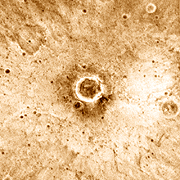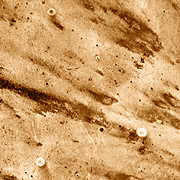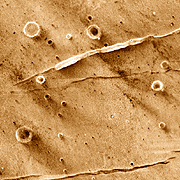Gratteri Crater's Far-Flung Rays
Seen through binoculars or a telescope, a Full Moon shows bright, star-shaped patterns called rays surrounding fresh-looking craters. The Moon's rays are made of shattered rock flung out in meteorite impacts, according to lunar scientists.
Do craters on Mars have rays? They should, because meteorites slam into Mars just as they do the Moon. But Martian crater rays have been hard to find. Perhaps the atmosphere inhibits their formation or dust settles on them and covers their traces - or maybe they just don't stand out to the eye.
A paper published in 2006 in the Journal of Geophysical Research-Planets by a team led by Livio Tornabene (University of Arizona) presents results of a Martian crater ray survey. Rays are indeed scanty on Mars, they found. But the team turned up three probable cases and five definite ones, among them the pattern surrounding Gratteri Crater, seen here.
If Gratteri's rays look oddly dark compared to the bright ones around lunar craters, there's a good reason. Lunar ray images are usually taken at visible wavelengths (corresponding to what the eye sees) and rays show up best that way.
But this image is a mosaic of infrared frames taken by the Thermal Emission Imaging System (THEMIS) on NASA's Mars Odyssey orbiter. It shows Mars by night. The image was taken in the wee hours before dawn and it records heat coming from the ground.
After the Sun sets on Mars, just as in deserts on Earth, the ground gives up heat to the cold night sky. Dust, sand, and fine-grain materials cool quickly and have become very cold as dawn approaches. Rocks, boulders, and hardened sediments, however, lose heat far more slowly and do not chill down as much by the time night is ending. Because rays are made of small-grain debris, they grow cold and appear dark.
The key to understanding this infrared THEMIS image is to remember that brighter tones mean warmer and rockier areas, while darker ones indicate cooler and dustier terrain. Nighttime infrared views thus give scientists important clues about the nature of the surface.

Necklace of Rocks
Gratteri Crater spans 6.9 kilometers (4.3 miles) but its rays, which number more than 30, reach vastly farther. The researchers mapped Gratteri's rays out to a distance of 595 km (370 mi) from the crater center. But closest to the crater, rays vanish from the picture.
Instead, the crater's rim is marked with a bright ring. To THEMIS' heat-attuned eyes, this represents warmth from exposed rocks at the rim crest. Surrounding this is a darker collar, varying in width. The tone indicates the collar is made of fine-grain material, such as sand or dust, or is thickly coated with it. Thus the surface has cooled more than the rimrock has during the hours after sunset.
A THEMIS view of this area by day shows a blanket of material ejected by the impact that made Gratteri. In addition, the ejecta shows signs of having flowed thanks to a fluid, probably melted ground ice, that became trapped in the debris during the impact. Some of this material seems to have pooled in the small crater next to Gratteri on its southwest side.
Outside the dark collar lies a broad necklace, roughly circular and generally bright. A few craters have made tiny, dark, dust-filled pocks across the area, but overall the bright tone indicates a relatively warm, hence rocky, surface.
The warm area may be a sheet of rocky debris - or an expanse of bedrock swept clean of loose material, perhaps by the blast wave of the impact. The pockmarks may indicate where big blocks of debris flung out in the impact made secondary craters that now act as traps for dust or sand.

Cool Rays
Outside the rocky necklace lies the domain of the rays. These appear dark because they are cold, thanks to their fine-grain nature.
These rays are also somewhat more clumped than lunar rays, possibly reflecting the fact that Mars has an atmosphere while the Moon doesn't.
When debris shoots at high speed through an atmosphere, the finest material tends to stop or diffuse quickly, while somewhat larger and denser clots of debris fly onward. In general, the rays' shape shows that the larger debris usually flies slower and hits first, then a tail of finer debris continues downrange before petering out.
A look at the overall ray pattern, however, shows the debris is not completely symmetrical around Gratteri. The rays lie longest and are most developed to the northwest and southeast of the crater. Such a "butterfly" distribution hints the impacting body struck at an oblique angle.
If so, the impactor likely came from the northeast. Experiments in test chambers show that oblique impacts tend to throw relatively little debris back uprange. Thus a relative lack of rays toward the north-northeast suggests this was the direction from which the meteorite came.

Cosmic Litterbug?
Gratteri Crater lies in a region called Memnonia Fossae. Memnonia's surface is heavily cratered, thus old, and numerous cracks (the fossaeof the name) slice across it. The cracks probably resulted from the volcanic and tectonic activity that built the immense volcanic region of Tharsis, about 1,800 km (1,100 mi) northeast.
Gratteri, a relatively fresh crater in an old region, poses a thought-provoking question first raised in connection with Zunil, another ray crater in a different part of Mars. Zunil has been studied as a possible source for one group of Martian meteorites on Earth, the shergottites, which are younger than 200 million years old.
In a similar way, say the researchers, Gratteri might be the source crater for ALH84001, the Mars meteorite with the oldest age. (This meteorite became famous in 1996, when a few researchers proposed it contained microscopic fossils of early Mars life, a claim that most scientists say has not held up.)
ALH84001 last melted and solidified about 4.5 billion years ago, making it one of the oldest rocks known anywhere. The Memnonia region is among the oldest and most cratered on Mars, and rocks exposed there, especially if heaved up by multiple impacts, could plausibly date back that far.
Gratteri Crater appears fresh enough to have formed within the last 20 million years or less, the researchers note. Is it the source crater for ALH84001?
At this point, it's hard to say. Proving a connection would require a mission to collect samples from Gratteri and its vicinity. But that's not likely to happen for a few decades at least.